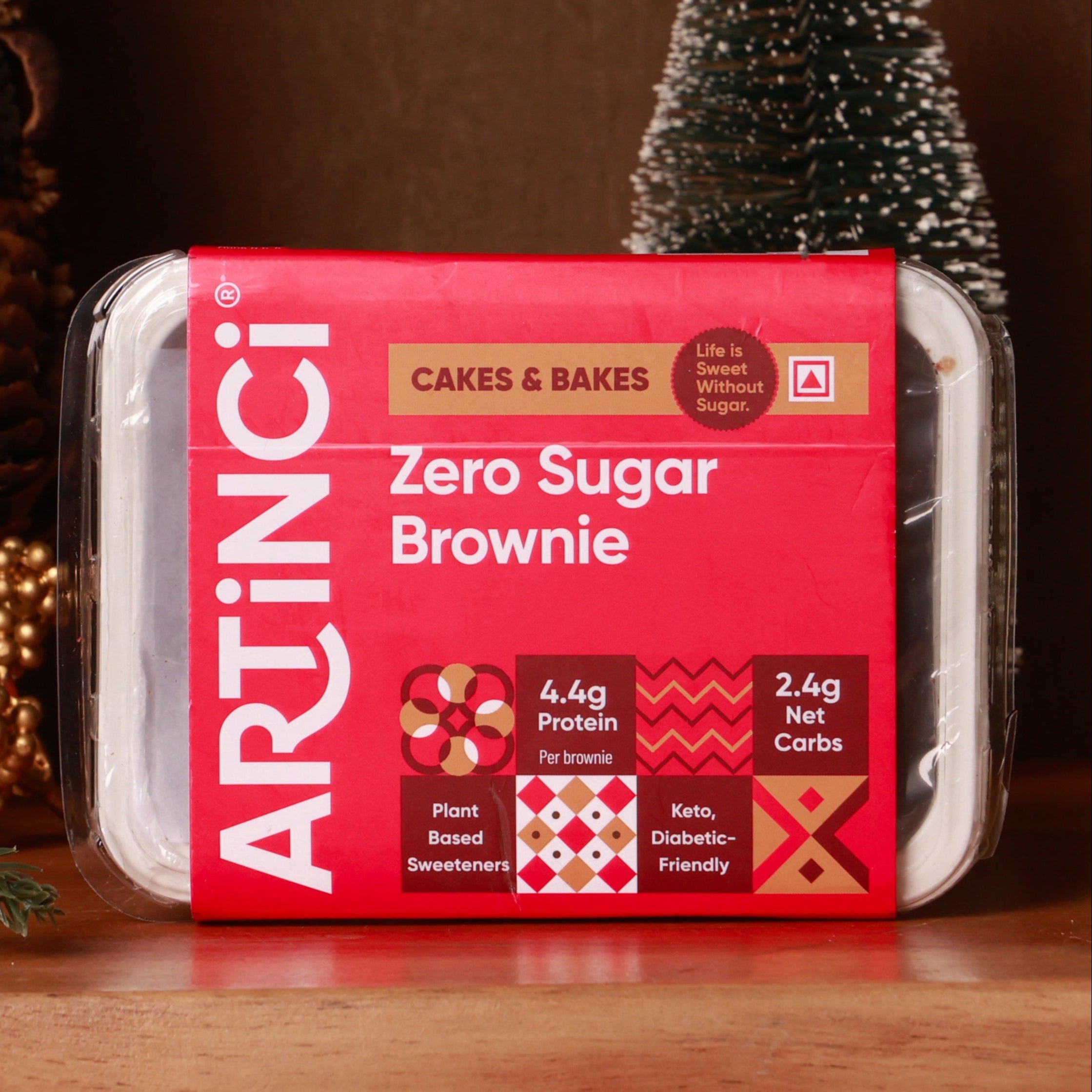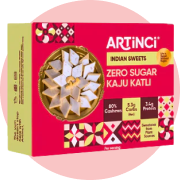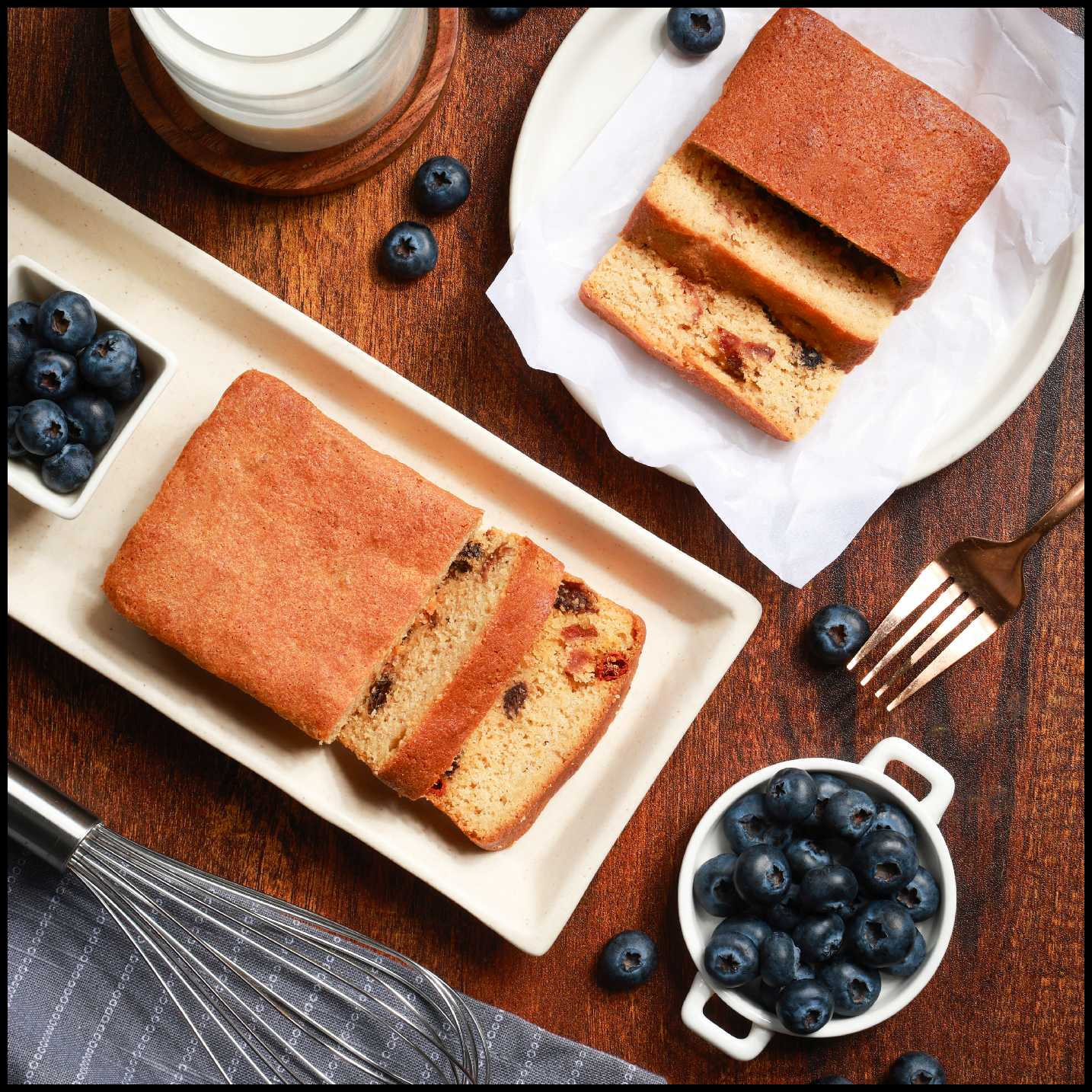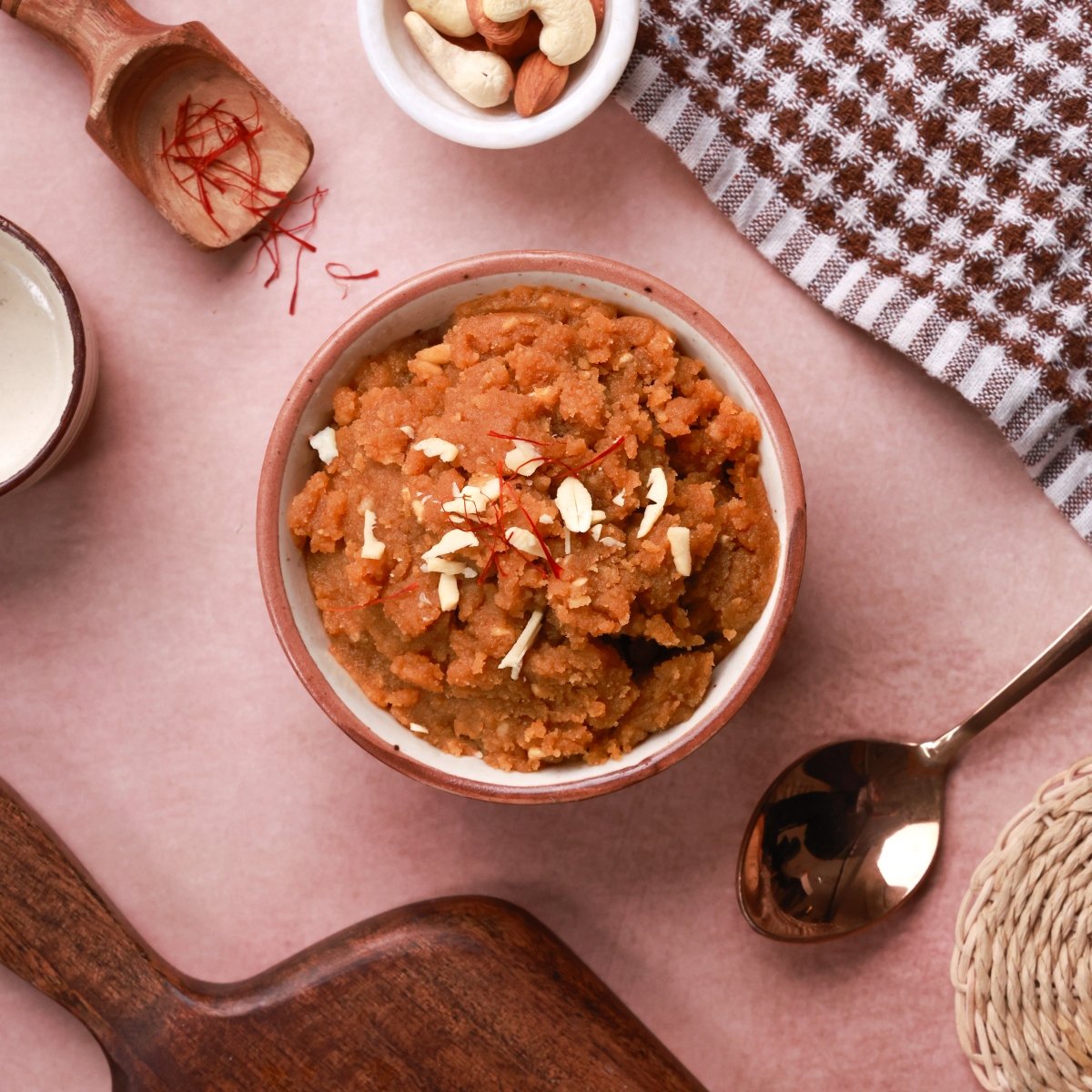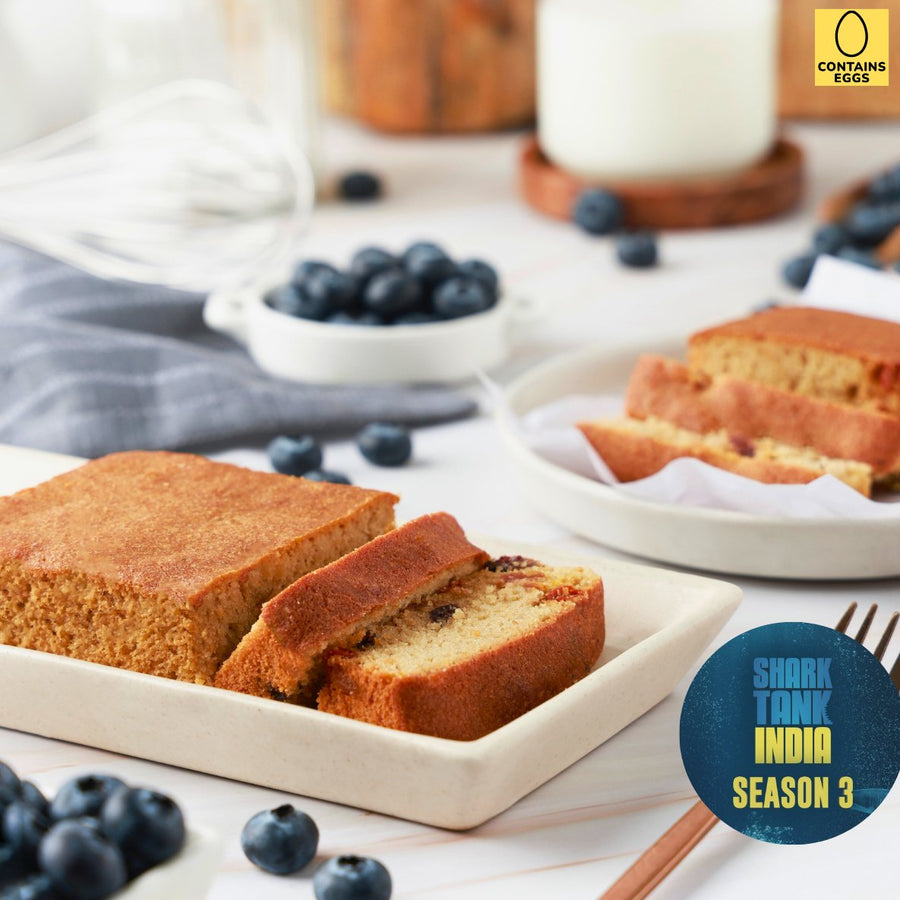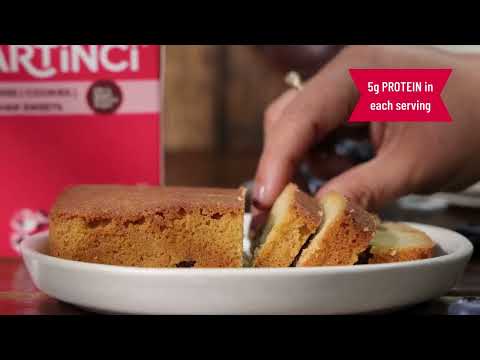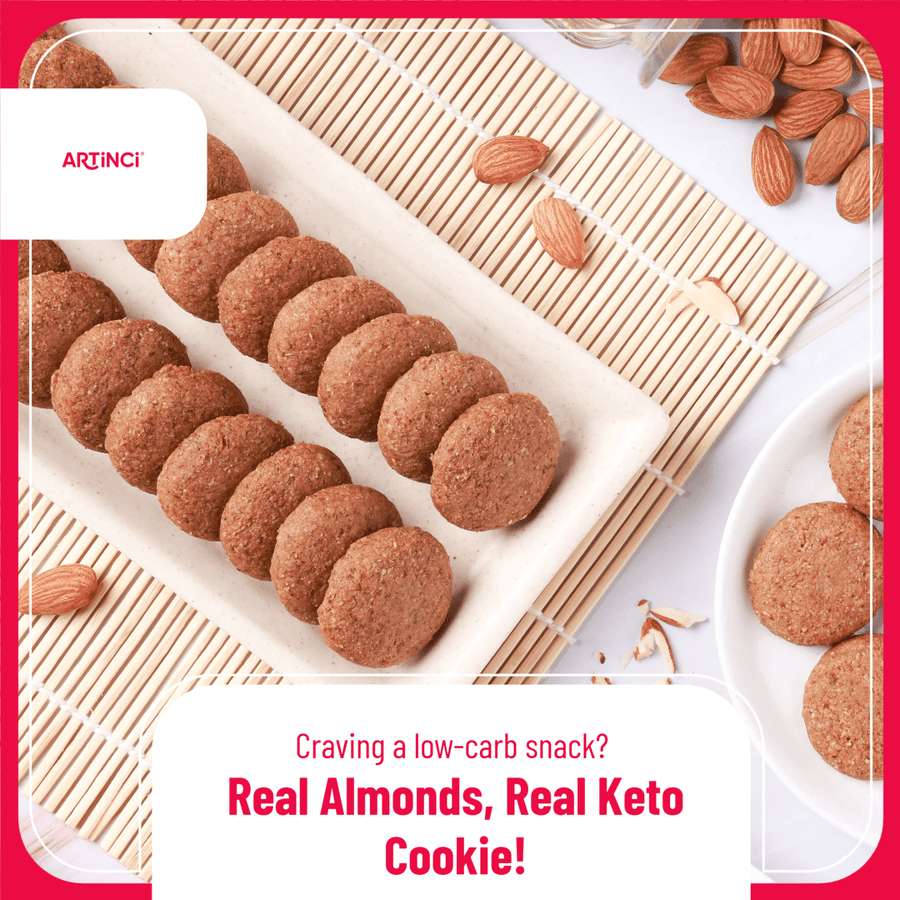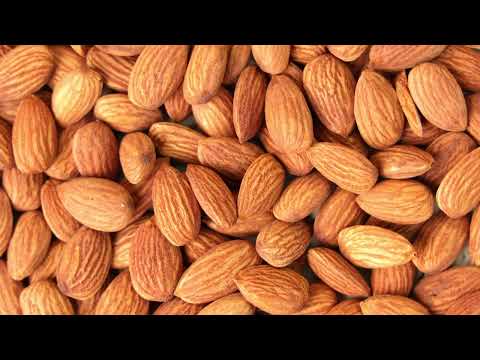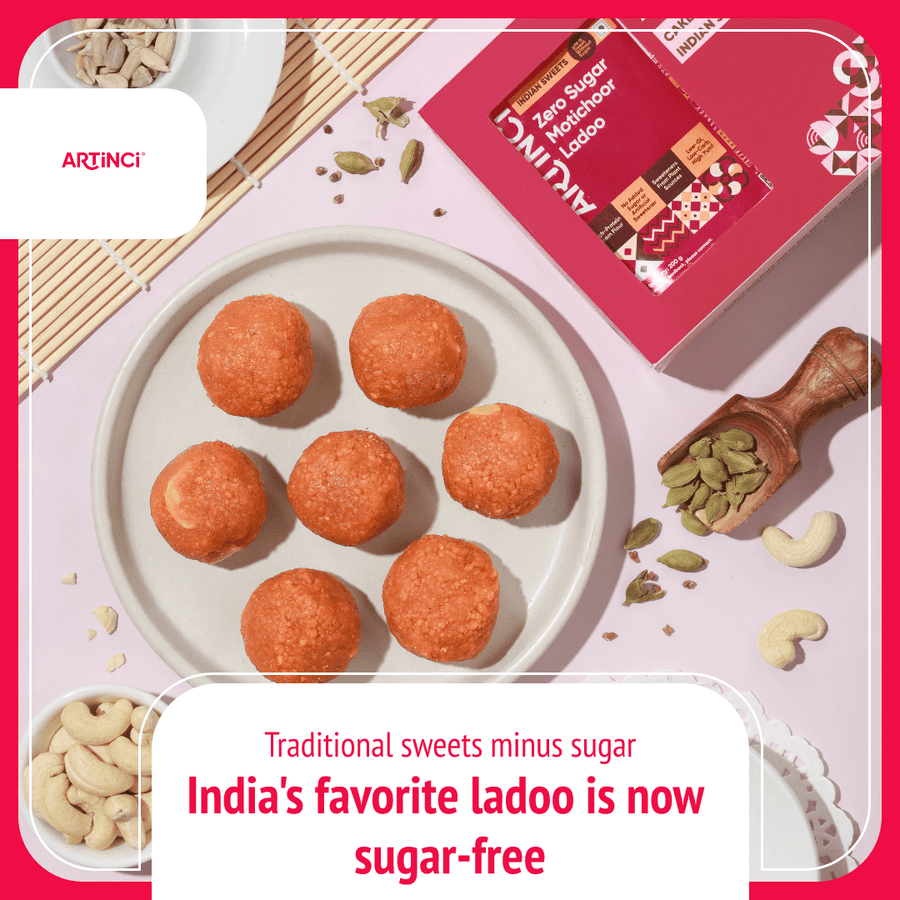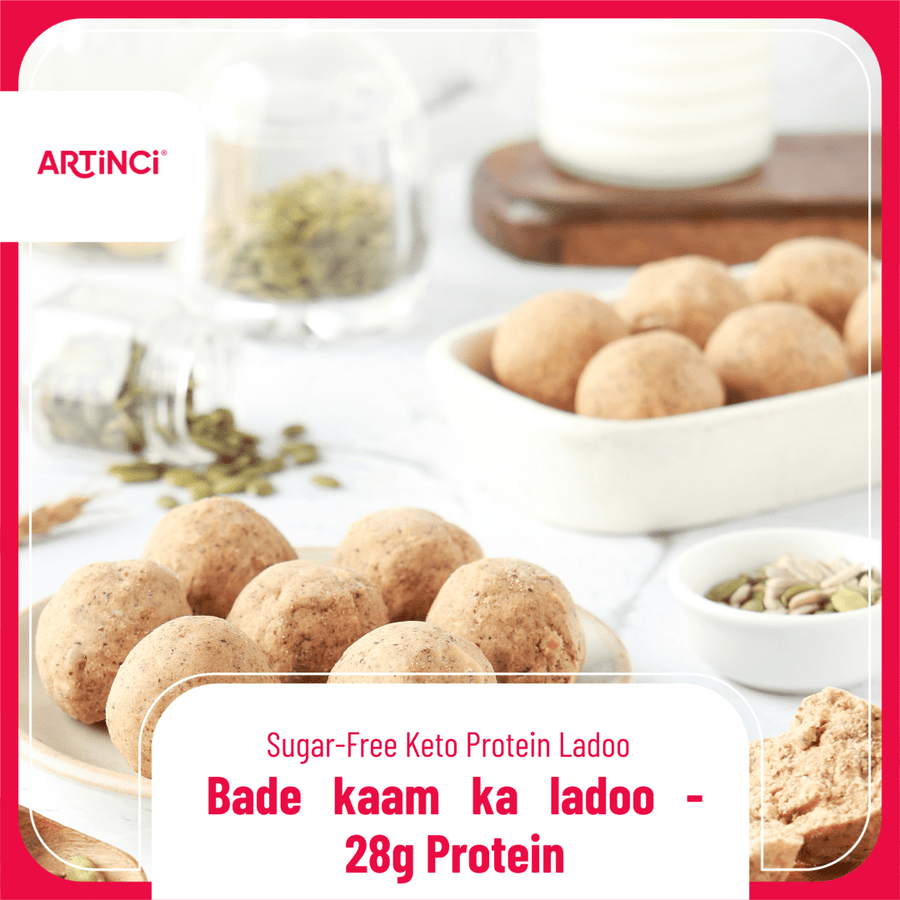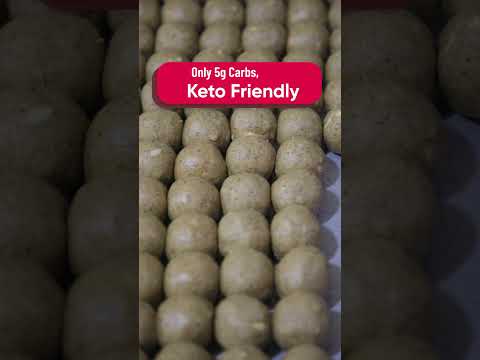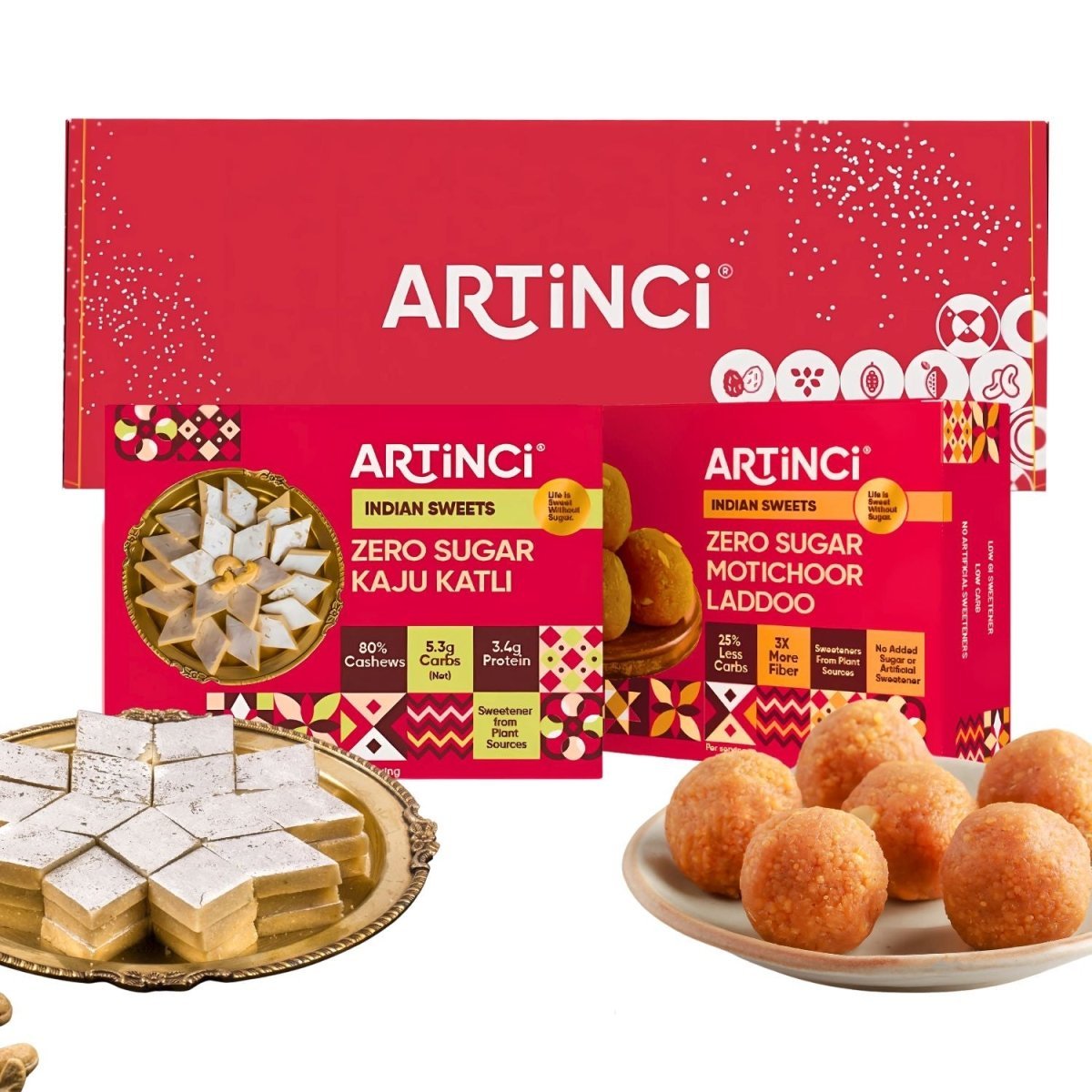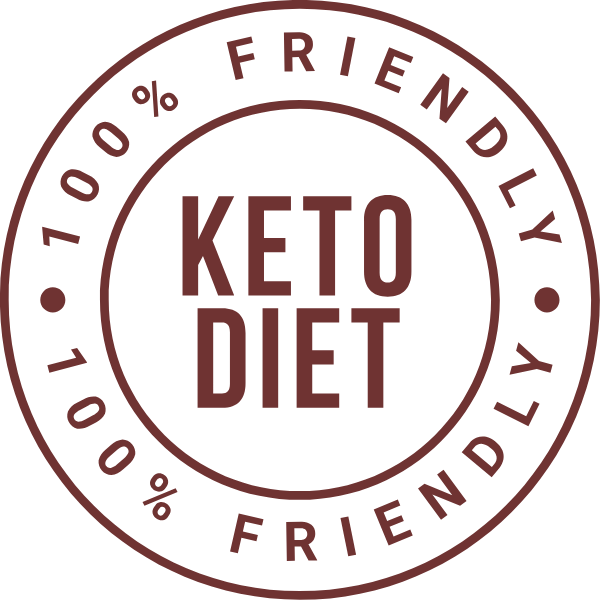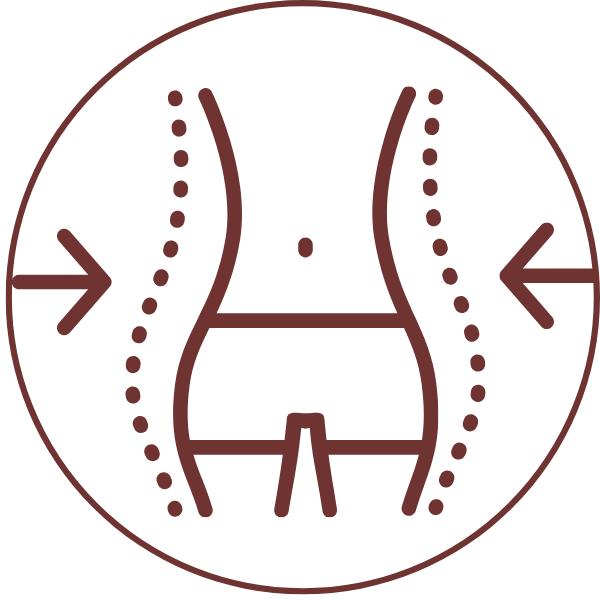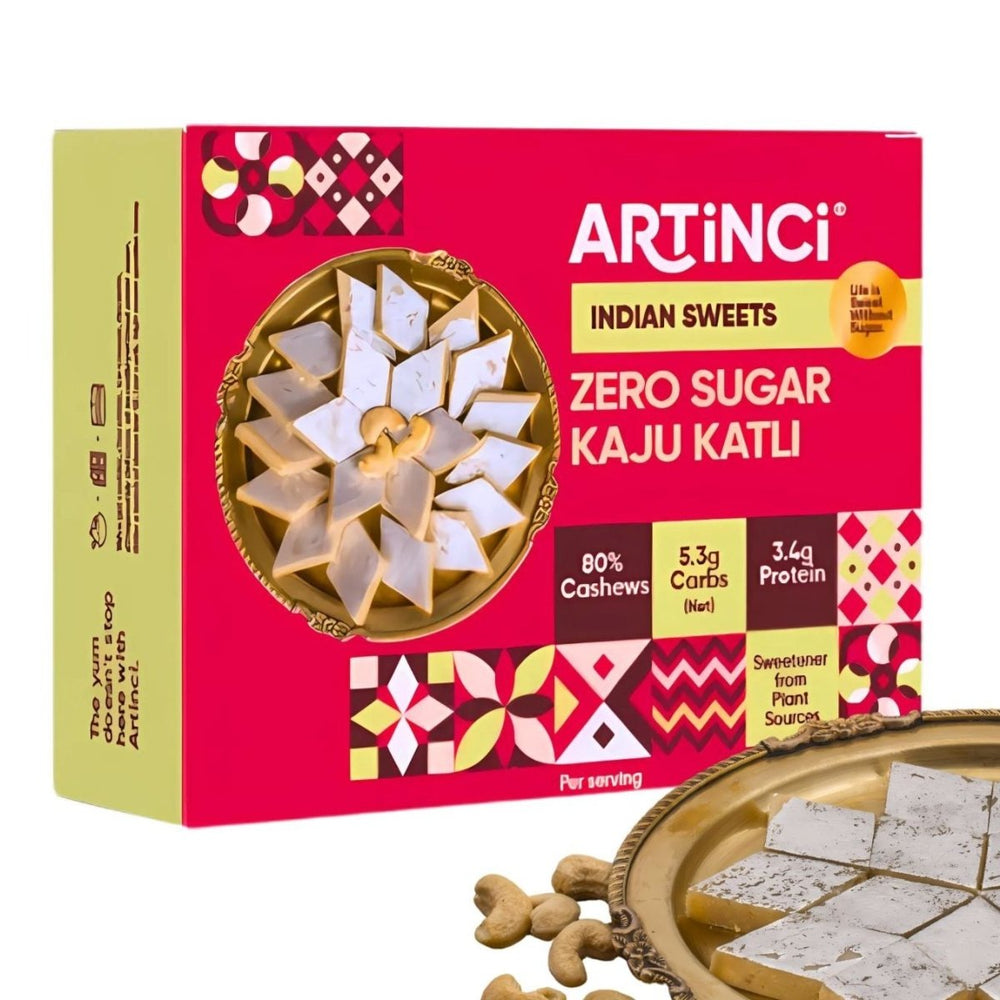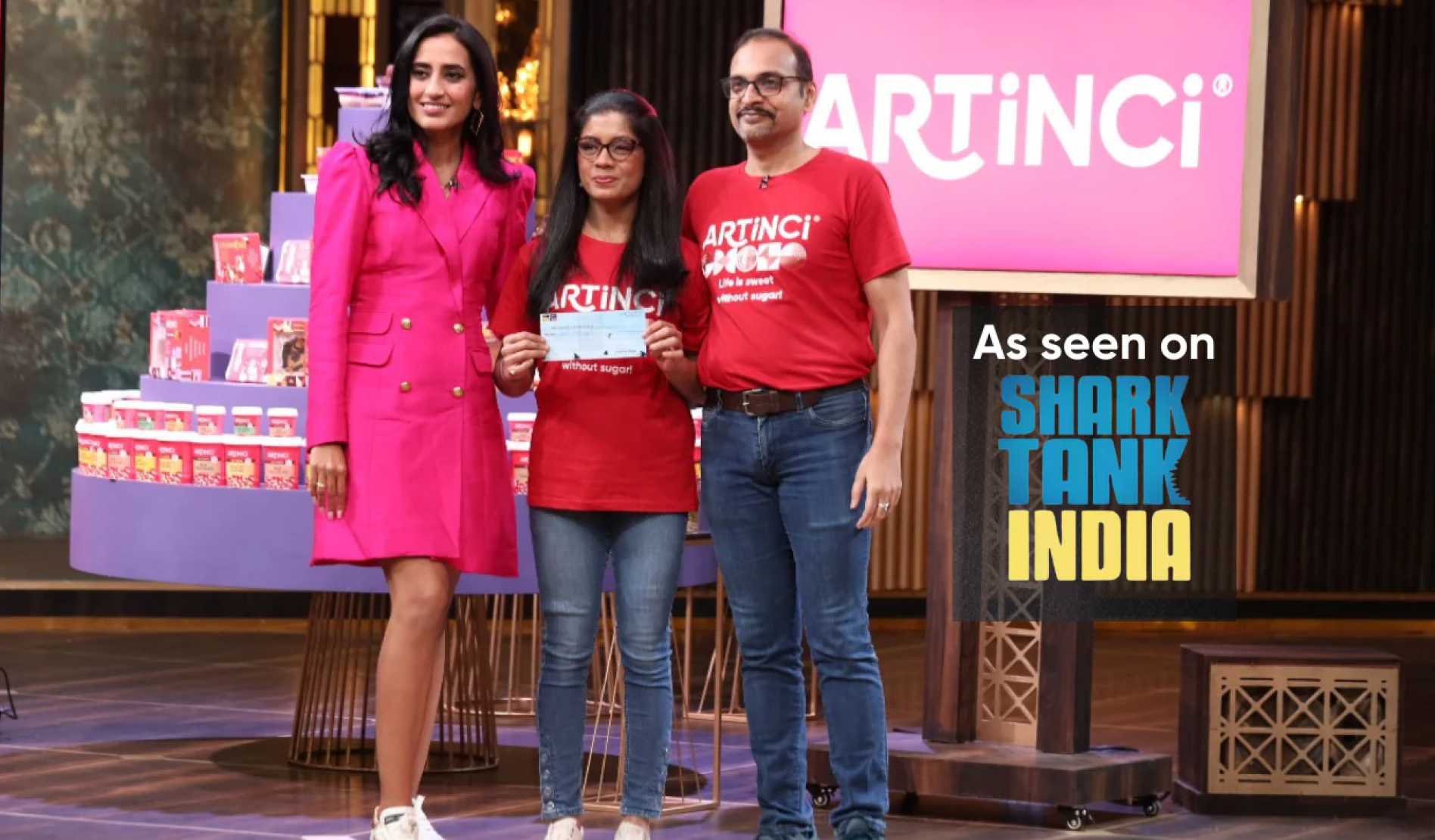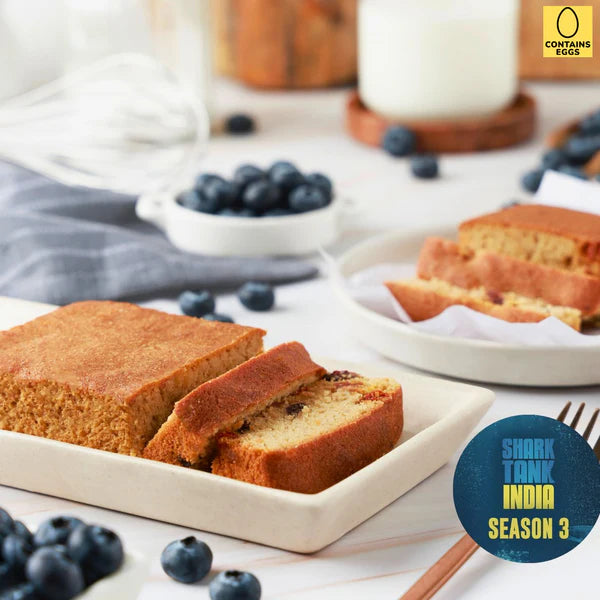Welcome to the world of sugar free joy!
Low Carb Sugar-Free Desserts & Snacks
Artinci was born out of Aarti's and Sumit's (Artinci's founders) abiding love for great-tasting dessert, while helping them stay committed to their health goals as well. As a result, Artinci makes delicious desserts with zero sugar, that are science and evidence-backed.
Aarti and Sumit come from a family of three generations of diabetics. They were themselves diagnosed pre-diabetic in 2012, and right there began a lifelong quest of a healthy, active lifestyle, including healthy swaps in food
Indulgent Halwas & Cozy Cakes


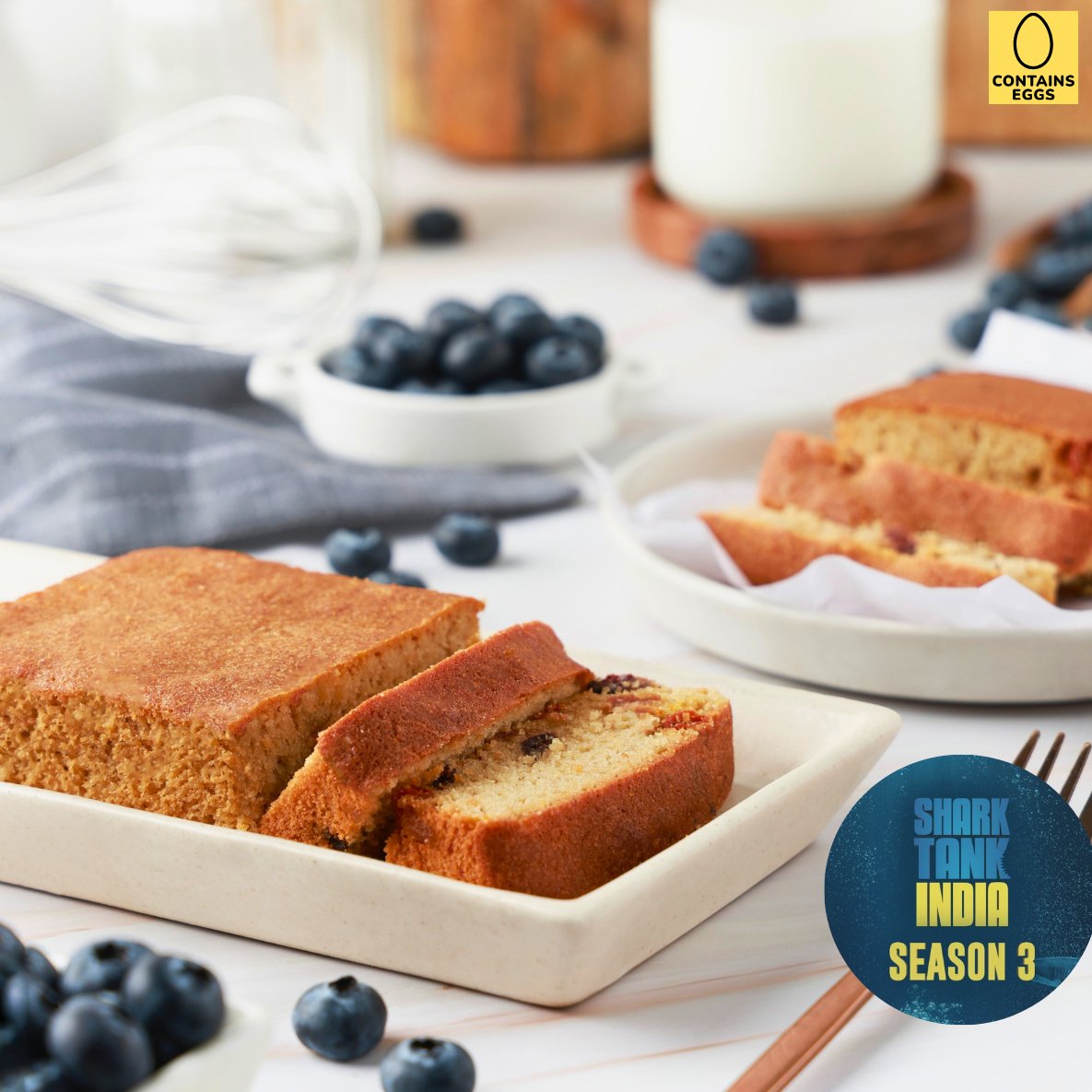
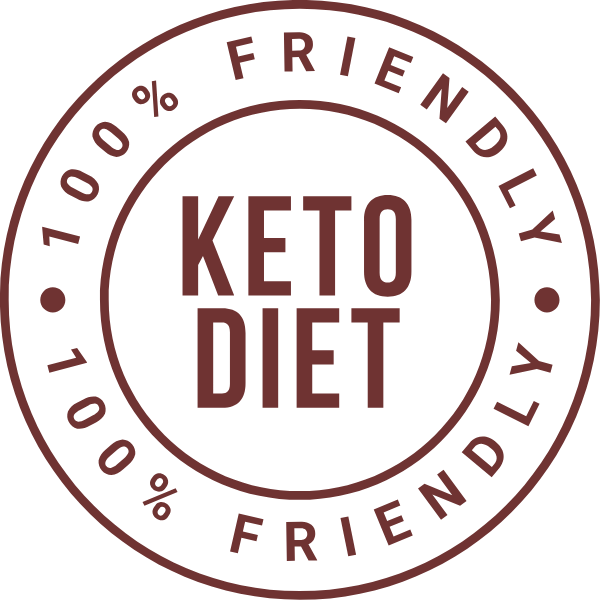

Berries Almond Cake - Sugar-Free, Keto, Gluten-Free, Diabetic-friendly (contains egg)


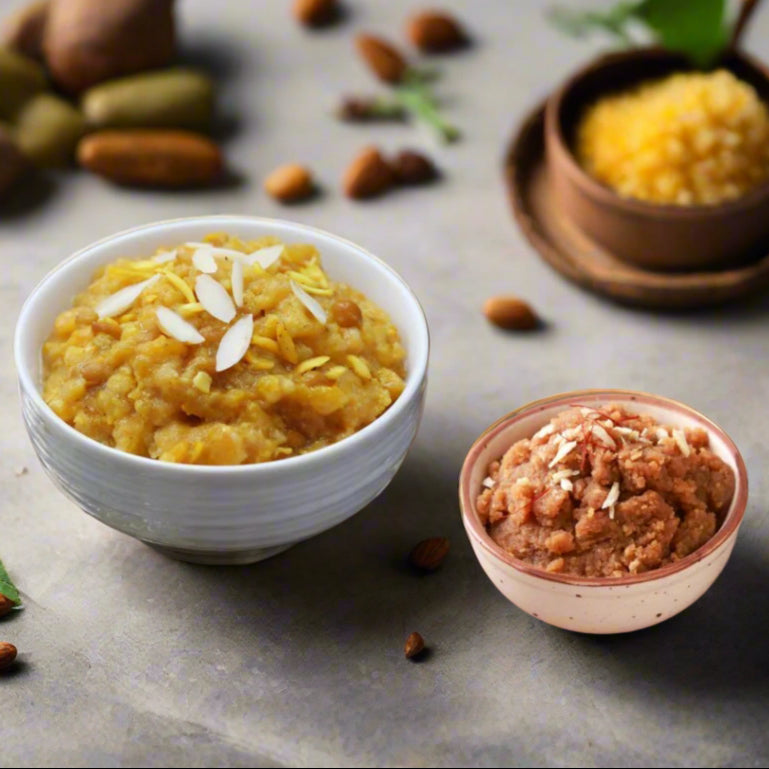
Sugar free Halwa combo @499


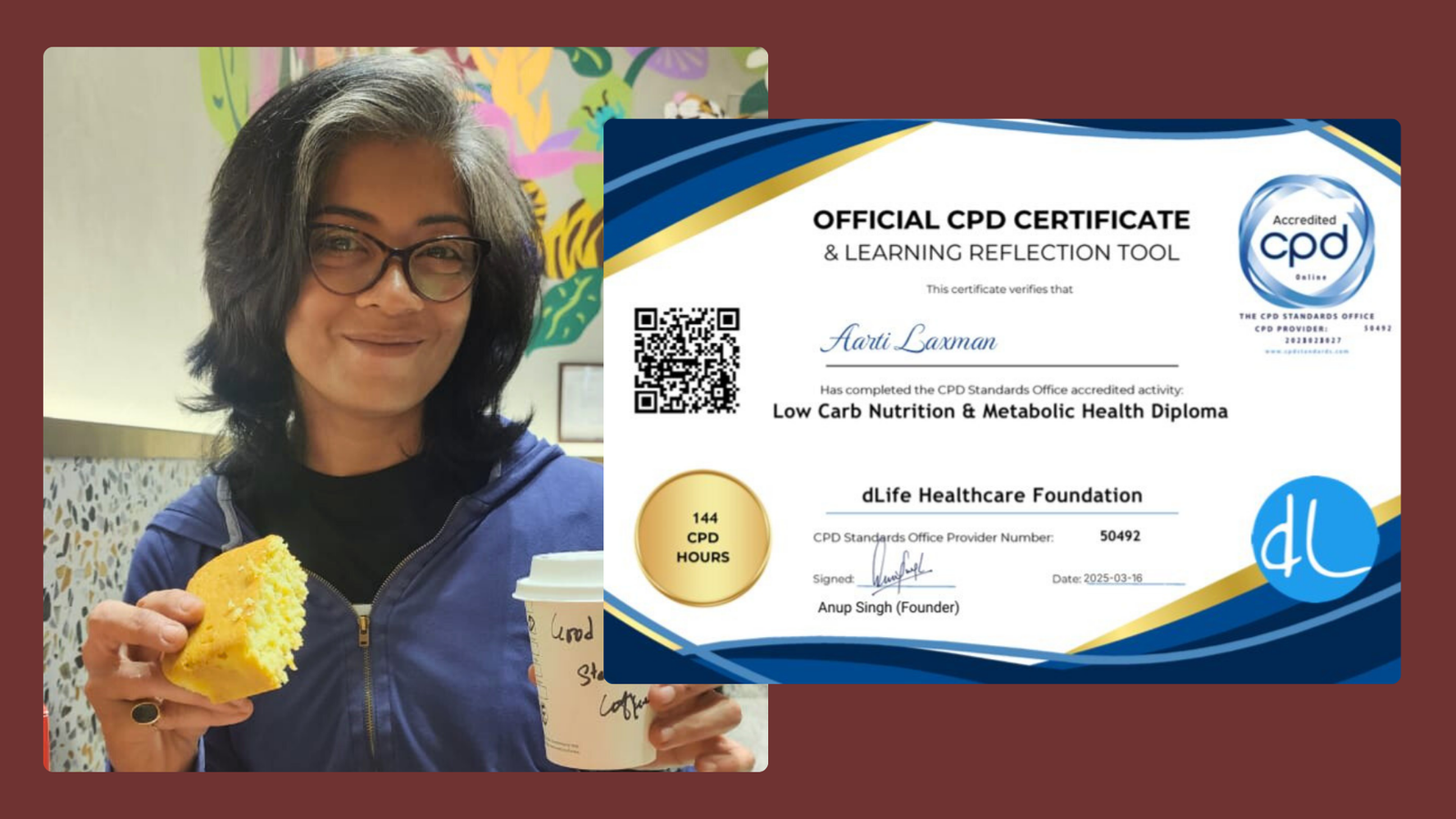
Aarti Laxman (Founder)
Artinci is founded by Aarti Laxman, a certified Metabolic coach in the Low-Carb Nutrition & Metabolic Health domain from dLife.in, India’s only legally tenable course in this subject—recognized by the NSDC (under the Ministry of Skill Development & Entrepreneurship, Govt. of India). It’s also internationally accredited by the CPD Standards Office UK, with a global record of 144 CPD hours—the highest for any course of its kind. The accreditation is both nationally valid and globally recognised in over 50+ countries..
Festive Gifting in Artinci
Let customers speak for us
All about Sugar and sugar-free

Low carbohydrate diets have transformed the way millions approach weight loss and health optimization. The Keto diet, Paleo diet, and various Low carb diet approaches have surged in popularity, each promising unique benefits and lifestyle changes.You've likely encountered success stories from friends, social media influencers, or health enthusiasts who swear by one of these approaches. The challenge lies in determining which path aligns with your specific needs, preferences, and long-term goals.Keto, Paleo, or Low Carb – What's Right for You? This question requires careful consideration of your lifestyle, health objectives, and dietary preferences. Each approach offers distinct advantages and challenges, making the choice highly personal.The key to sustainable success lies in selecting a diet comparison that matches your daily routine, food preferences, and health requirements. Your journey toward better health deserves a thoughtful approach that considers both immediate results and long-term sustainability.For instance, if you're managing gestational diabetes, you might need a more tailored low-carb approach. On the other hand, if you're simply looking for a weight loss solution or a lifestyle change, one of the popular low-carb diets like Keto or Paleo could be beneficial.Moreover, it's essential to consider the environmental impact of your dietary choices. Many e-commerce deliveries associated with diet plans can contribute to carbon emissions. However, some companies are taking steps towards a more sustainable future by adopting a climate commitment that includes carbon-neutral shipping options.Ultimately, the most important aspect is finding a diet plan that not only helps you achieve your desired results but also aligns with your values and lifestyle.Understanding the Basics of Each DietNavigating the world of low-carbohydrate eating requires understanding the distinct approaches each diet takes. While all three methods reduce carbohydrate intake, their philosophies, food choices, and metabolic targets differ significantly.The Keto Diet ExplainedThe Keto diet basics center around achieving ketosis, a metabolic state where your body shifts from burning glucose to burning fat for energy. This high-fat diet forces your liver to convert fat into ketones, which serve as an alternative fuel source for your brain and muscles.Macronutrient Ratios for KetoMacronutrient ratios keto followers must maintain are precise and non-negotiable: Fat: 65-90% of total daily calories Protein: 10-30% of total daily calories Carbohydrates: Less than 5% of total daily calories This typically translates to consuming fewer than 20-50 grams of net carbohydrates per day, depending on your individual tolerance and activity level.Allowed and Restricted Foods on KetoThe high-fat diet approach allows specific foods while restricting others:Allowed Foods: High-fat dairy products (butter, heavy cream, full-fat cheese) Fatty meats and fish Eggs Nuts and seeds (in moderation) Low-carb vegetables (leafy greens, broccoli, cauliflower) Healthy oils (olive oil, coconut oil, avocado oil) Restricted Foods: Most fruits (except small portions of berries) All grains and cereals Legumes and beans Starchy vegetables (potatoes, corn, carrots) Sugar and sweetened products However, some may wonder if alternatives like jaggery could be viable options for sweetening without spiking sugar levels.Most processed foodsImportance of Tracking MacrosYou must track your macronutrients meticulously to maintain ketosis. Even small deviations from these ratios can kick you out of this metabolic state, requiring several days to re-enter ketosis.The Principles of the Paleo DietThe Paleo diet is based on the idea of eating like our ancestors did during the Paleolithic era, which was about 10,000 years ago. It encourages us to consume whole, unprocessed foods that are similar to what they would have eaten.What Foods Are Included in the Paleo Diet?The focus of the Paleo diet is on nutrient-rich foods that come from nature. Instead of counting macronutrients (carbohydrates, proteins, and fats) strictly, this way of eating promotes: Meats - grass-fed beef, wild game, poultry Fish and seafood - wild-caught varieties preferred Eggs - from pasture-raised chickens Nuts and seeds - almonds, walnuts, sunflower seeds Fruits - all varieties except corn (considered a grain) Vegetables - excluding corn and other processed varieties Healthy fats - avocado, olive oil, coconut oil What Foods Are Excluded from the Paleo Diet?The following foods are not allowed on the Paleo diet: Grains (such as wheat, rice, oats) Legumes (including beans, lentils, peanuts) Dairy products (except for grass-fed butter) Refined sugars (like white sugar and high fructose corn syrup) Processed foods (anything that comes in a package with ingredients you can't pronounce) Flexibility in Carbohydrate IntakeOne key difference between Paleo and other diets like keto is the flexibility it offers in carbohydrate intake. While keto requires strict adherence to specific macronutrient ratios, Paleo allows for more freedom when it comes to carbs.You can enjoy higher-carb fruits and starchy vegetables while still following the main principles of the diet.Lifestyle Factors Matter TooIn addition to food choices, the Paleo diet also emphasizes the importance of certain lifestyle factors: Regular exercise Adequate sleep Stress management techniques Mindfulness practices This holistic approach sets Paleo apart from purely nutritional frameworks. It's not just about what you eat; it's also about how you live your life.By incorporating these lifestyle habits alongside a healthy diet, you can achieve overall well-being rather than simply focusing on dietary restrictions alone. Furthermore, adopting such a lifestyle can lead to significant health improvements as evidenced by various studies on the topic, including those found in this article.Overview of Low Carb DietsLow carb diets are a wide range of eating plans that reduce carbohydrate intake without following the strict macronutrient ratios or ketosis requirements of the Keto diet. These approaches offer more flexibility than Keto while still limiting carbs to promote weight management and metabolic benefits.The Atkins diet is an example of this category with its phased approach, starting with very low carbs (20-25 grams daily) and gradually increasing intake as you progress through different phases. You can eventually consume 80-100 grams of carbs daily while maintaining weight loss.The carnivore diet takes restrictiveness to another extreme, eliminating all plant-based foods and focusing exclusively on animal products. This approach delivers zero carbs from plant sources, making it more restrictive than even Keto in terms of food variety.Other low carb diet types include: Modified Atkins (allows 15-20 grams of carbs daily) South Beach Diet (emphasizes lean proteins and healthy fats) Protein Power (focuses on adequate protein with moderate fat) Each low carb approach varies significantly in food sources, restrictiveness levels, and long-term sustainability, allowing you to choose based on your personal preferences and lifestyle demands.Health Benefits and Goals of Each DietEach dietary approach targets distinct health outcomes, making your choice dependent on what you want to achieve. Weight loss keto paleo low carb strategies all offer unique pathways to better health, but their mechanisms differ significantly.Ketogenic Diet: Fat Metabolism and Blood Sugar ControlThe ketogenic diet prioritizes weight loss through fat metabolism and blood sugar control mechanisms. By forcing your body into ketosis, you transform into a fat-burning machine while stabilizing glucose levels. This metabolic shift can lead to rapid initial weight loss and improved insulin sensitivity, making it particularly appealing for those managing diabetes or metabolic syndrome.Paleo Diet: Nutrient-Dense Whole Foods for General HealthPaleo takes a different route, emphasizing nutrient-dense whole foods for general health. You're not counting macros or forcing ketosis—instead, you're flooding your body with vitamins, minerals, and antioxidants from unprocessed sources. This approach supports inflammation reduction, digestive health, and sustained energy levels through natural food choices.Low Carb Diets: Flexibility Based on Individual PreferencesLow carb diets offer the most flexibility, allowing you to tailor your approach based on individual preferences. Whether you choose moderate carb reduction or more aggressive restrictions like carnivore eating, you can adjust your plan to match your lifestyle while still achieving weight management goals.Incorporating sugar-free substitutes like erythritol can also be beneficial in these diets. Erythritol is a popular choice among those following keto or low-carb diets due to its low-calorie content and minimal impact on blood sugar levels.For those who enjoy sweets but are mindful of their sugar intake, there are options available such as sugar-free biscuits, cookies, and even festive treats like Kaju Katli and Motichoor Ladoo. These products allow you to indulge in your cravings without compromising your dietary goals.Potential Side Effects and RisksEvery dietary approach comes with potential drawbacks you should consider before making changes to your eating habits.Immediate Challenges of KetoKeto presents several immediate challenges during the adaptation phase. The keto flu side effects typically emerge within the first week and can include fatigue, headaches, irritability, and digestive issues as your body transitions from glucose to fat metabolism. These symptoms usually resolve within 7-14 days, but they can be uncomfortable enough to derail your efforts.Nutrient Deficiencies and RisksNutrient deficiencies keto paleo risks become more pronounced with stricter adherence. Keto eliminates many nutrient-dense foods like fruits and whole grains, potentially leading to deficiencies in fiber, magnesium, and B vitamins. However, incorporating fiber-rich foods could help mitigate some of these deficiencies. Paleo diets may lack calcium and vitamin D due to dairy restrictions, while extremely restrictive low carb approaches like carnivore diets risk vitamin C and fiber deficiencies.Long-Term ConcernsLong-term concerns require careful consideration. Keto may increase risks of kidney stones, osteoporosis, and elevated cholesterol levels in some individuals. The high saturated fat intake raises questions about cardiovascular health, though research remains mixed.Lack of Long-Term Safety DataAll three dietary approaches lack extensive long-term safety data. Most studies focus on short-term outcomes, leaving questions about sustained adherence and health impacts over decades unanswered.Finding Suitable AlternativesDespite these challenges, it's possible to find suitable alternatives that align with these dietary restrictions. For instance, enjoying a Kaju Katli (a sugar-free sweet treat ideal for keto dieters) or gluten-free almond cookies (which can fit into various dietary plans) can provide a delightful reprieve from the usual restrictions of these diets.Lifestyle Compatibility and Sustainability Across DietsThe success of diets like keto, paleo, and low carb heavily depends on how well each approach fits into your daily routines and personal preferences. The most effective diet is one you can maintain consistently without feeling deprived or overwhelmed by complex requirements.Key Compatibility Aspects to ConsiderLifestyle factors play a crucial role in long-term success. Consider these key compatibility aspects when choosing a diet: Social dining flexibility - Paleo allows easier restaurant navigation compared to strict keto macronutrient tracking Meal preparation time - Keto requires precise measuring and calculating, while low carb approaches offer more intuitive eating Food budget constraints - High-fat keto foods and grass-fed paleo options can significantly increase grocery costs Travel and work schedules - Maintaining ketosis while traveling or during busy periods presents unique challenges Keto's rigid macronutrient ratios demand constant vigilance and mathematical precision. You must weigh portions, track every gram of carbohydrates, and maintain specific fat-to-protein ratios. This level of monitoring can become exhausting for busy professionals or parents.Paleo and flexible low carb approaches prioritize food quality over precise calculations. You can focus on choosing whole foods without obsessing over exact percentages, making these options more sustainable for varied lifestyles and social situations.Which Diet is Right for You? Factors to Consider When Choosing Between ThemChoosing the right diet between Keto, Paleo, or Low Carb requires honest self-assessment of your priorities and circumstances. Your health goals should guide this decision—if rapid weight loss and blood sugar control are primary concerns, Keto's metabolic approach may suit you best. For those seeking overall wellness through nutrient-dense whole foods, Paleo offers a balanced foundation.Consider your dietary preferences and restrictions carefully: Food intolerances: Dairy-sensitive individuals might struggle with Keto's high-fat dairy emphasis Social eating habits: Paleo's flexibility makes restaurant dining and social events more manageable Cooking preferences: Low Carb diets offer the widest variety of preparation methods Your lifestyle demands matter significantly. Busy professionals often find strict Keto macronutrient tracking overwhelming, while Paleo's whole-food focus requires minimal calculation. Athletes may benefit from Low Carb approaches that allow strategic carbohydrate timing.Medical conditions require professional guidance—consult your healthcare provider before making dramatic dietary changes, especially if you have diabetes, kidney issues, or eating disorder history.

How to Tame Post-Meal Sugar Cravings in 5 Easy Steps
Post-meal sugar cravings strike millions of people daily, creating an almost irresistible urge for something sweet right after finishing a meal. You've likely experienced this phenomenon yourself – that sudden desire for dessert, candy, or a sugary treat despite feeling physically satisfied from your meal.Why crave sugar after eating? Your brain chemistry plays a significant role in these cravings. Sugar triggers the release of serotonin and endorphins, creating a pleasurable sensation that your brain remembers and seeks to repeat. Hormonal fluctuations involving insulin, estrogen, and progesterone can intensify these desires, making them feel almost impossible to ignore.The composition of your meal directly influences how intense your sugar cravings after a meal become. Meals heavy in simple carbohydrates without adequate protein or healthy fats create rapid blood sugar spikes followed by crashes. These crashes signal your brain to seek quick energy sources – namely sugar – creating a cycle that keeps you reaching for sweets.Understanding these mechanisms empowers you to break free from post-meal sugar cravings using targeted strategies that address both the physical and psychological aspects of your cravings. For instance, if you're managing conditions like gestational diabetes, it's essential to understand how certain foods affect your blood sugar levels and cravings.Moreover, if you ever find yourself in need of satisfying those sweet tooth cravings while still being mindful of your dietary restrictions, exploring options like those available on Artinci could be beneficial. They offer a range of products including cakes, cookies, and chocolates that cater to various dietary needs.Lastly, if you're considering making online purchases for these products, it's important to understand the delivery policy to ensure a smooth shopping experience.1. Eat Balanced Meals to Stabilize Blood SugarBalanced meals for sugar control form the foundation of craving management. When you combine protein, healthy fats, and fiber-rich foods in each meal, you create a steady release of glucose into your bloodstream. This prevents the dramatic blood sugar spikes and crashes that trigger intense sugar cravings within hours of eating.Simple carbohydrates without adequate protein and healthy fats cause rapid glucose absorption, leading your pancreas to release large amounts of insulin. This insulin surge quickly drops your blood sugar below normal levels, sending urgent signals to your brain demanding quick energy - typically in the form of sugar.Consider these craving-reducing meal combinations: Breakfast: Greek yogurt with berries, nuts, and chia seeds Lunch: Grilled salmon with quinoa and roasted vegetables Dinner: Lean chicken breast with sweet potato and steamed broccoli Each meal includes complete protein (20-30 grams), healthy fats from nuts or avocado, and fiber-rich foods that slow digestion. You'll notice fewer afternoon sugar cravings when your morning includes protein and fiber rather than sugary cereals or pastries alone.In addition to balanced meals, it's essential to be mindful of the types of sweeteners you incorporate into your diet. For instance, while some may consider jaggery as a healthier alternative, it's crucial to understand its effects on blood sugar levels.Similarly, if you're looking for sugar alternatives, erythritol is a popular choice among many due to its low glycemic index. However, it's essential to learn about its benefits and risks before making a switch.For those with specific dietary needs such as diabetes, exploring options like sugar-free sweets can be beneficial. With products designed for such requirements, you can indulge your sweet tooth without compromising on health.Lastly, if you're looking for traditional Indian sweets that cater to dietary restrictions such as sugar-free options during festive seasons or celebrations, there are numerous choices available that ensure taste without the added sugars.2. Choose Natural Sweet AlternativesYour body's desire for sweetness doesn't have to derail your health goals. Natural sweet foods can satisfy your taste buds while providing essential nutrients that processed sugars lack. These whole food options work with your body's natural processes rather than against them.Sweet Potatoes: Nutritional PowerhousesSweet potatoes stand out as nutritional powerhouses that deliver natural sweetness alongside fiber, potassium, and beta-carotene. A medium roasted sweet potato provides sustained energy without the blood sugar rollercoaster that triggers additional cravings. You can enjoy them baked, mashed, or even as sweet potato fries for a satisfying post-meal treat.Incorporating fiber-rich foods like sweet potatoes into your diet can significantly help in managing blood sugar levels, especially during periods like Ramadan when fasting is common. Read more about how fiber supports diabetes control during Ramadan for more insights.Nuts as Snacks: Satisfying Sweet CravingsNuts as snacks offer another excellent strategy for managing sweet cravings. Almonds, walnuts, and pecans contain natural oils and proteins that promote satiety while delivering a subtle sweetness. A small handful of dates stuffed with almond butter creates a dessert-like experience that your brain recognizes as satisfying.These healthy alternatives to sugar help retrain your palate to appreciate natural flavors. When you consistently choose whole food options, your reliance on processed sweets diminishes naturally. Your taste buds adapt, making artificially sweetened foods taste overwhelmingly sweet and less appealing over time.However, if you're looking for a guilt-free indulgence that still satisfies your sweet tooth, consider trying our Kaju Katli and Almond cookies combo. The Kaju Katli is sugar-free and diabetic-friendly, making it the perfect keto-friendly option while the gluten-free almond cookies are packed with nutty flavors - a perfect guilt-free treat!3. Meet Nutritional Needs That Influence CravingsYour body's craving for sugar after meals often signals underlying nutritional deficiencies that directly impact your brain chemistry and hormonal balance. When you lack specific vitamins for reducing sugar cravings, your body may seek quick energy from sugar to compensate.Magnesium benefits extend far beyond muscle function - this mineral helps regulate blood sugar levels and supports serotonin production. Low magnesium levels can intensify sugar cravings and mood swings. You'll find magnesium in dark leafy greens, pumpkin seeds, and dark chocolate.Chromium zinc B vitamins vitamin C work together as a powerful quartet against cravings: Chromium enhances insulin sensitivity and glucose metabolism Zinc supports neurotransmitter function and taste perception B vitamins (especially B6 and B12) regulate mood and energy production Vitamin C helps manage cortisol levels during stress Common deficiencies in these nutrients create a perfect storm for increased sugar desire. You can address these gaps through nutrient-dense foods like lean meats, nuts, citrus fruits, and whole grains, or consider targeted supplementation after consulting with your healthcare provider.Understanding how to handle sugar cravings after a meal starts with nourishing your body's fundamental nutritional needs. This approach aligns with the insights from recent research which emphasizes the importance of meeting nutritional needs to effectively manage cravings.4. Adopt Lifestyle Changes to Support Craving ControlSleep hygiene and sugar cravings play a crucial role in your body's ability to resist sweet temptations. Poor sleep disrupts hormones like leptin and ghrelin, which regulate hunger and satiety, making you more susceptible to sugar cravings the following day. When you're sleep-deprived, your brain seeks quick energy sources, often in the form of sugary foods.Improving Sleep QualityImproving sleep quality requires consistent bedtime routines: Set a regular sleep schedule, going to bed and waking up at the same time daily Create a cool, dark sleeping environment Limit screen time at least one hour before bed Avoid caffeine after 2 PM Stress Management for CravingsStress management for cravings becomes essential since chronic stress elevates cortisol levels, triggering your body to seek comfort foods high in sugar. Elevated cortisol disrupts insulin sensitivity, creating blood sugar imbalances that fuel cravings.Physical Activity BenefitsPhysical activity benefits extend beyond weight management. Regular exercise naturally regulates serotonin and cortisol levels, reducing your reliance on sugar for mood enhancement. Even a 15-minute walk after meals can help stabilize blood sugar and diminish post-meal sweet tooth episodes.In addition to these lifestyle changes, it's important to consider the environmental impact of our consumption habits. For example, Adopting a climate commitment such as supporting businesses that remove carbon from the atmosphere can not only benefit the planet but also encourage mindful consumption, which may indirectly assist in controlling cravings.5. Use Behavioral Strategies to Manage CravingsTrigger Identification for Sugar CravingStart by recognizing patterns in your eating behavior to identify triggers for sugar cravings. You might notice that cravings tend to spike when you're feeling bored, stressed, or when you're in specific locations such as your couch or office desk. To gain better insight, keep a simple craving journal for a week where you note down the time, your mood, and your environment whenever you experience a sweet tooth.Distraction Techniques for CravingsDistraction techniques have proven to be remarkably effective in managing cravings, especially when implemented immediately. Here are some methods you can try: Chew sugar-free gum - the minty flavor often eliminates sweet desires Brush your teeth - creates a clean mouth sensation that discourages eating Engage in a 10-minute activity like calling a friend, organizing a drawer, or taking a short walk Drink herbal tea with naturally sweet flavors like cinnamon or vanilla These distraction techniques can be particularly useful if you're struggling with the urge to binge-eat.Environmental ControlYour environment plays a crucial role in managing cravings. To minimize temptation, store any sweets that you find hard to resist in opaque containers or high cabinets instead of keeping them on countertops where they are easily visible. Remember, you can't crave what you can't see.Mindful Eating HabitsPracticing mindful eating habits can also help you manage cravings effectively. Allow yourself small, planned indulgences instead of completely depriving yourself of sweets. When you do decide to treat yourself with a sweet snack, make sure to eat it slowly and savor each bite rather than mindlessly consuming it.For further insights into effective strategies for managing food cravings, consider exploring this comprehensive guide from The New York Times on food craving strategies.ConclusionManaging post meal sugar cravings requires patience and commitment to sustainable changes. You don't need to transform your eating habits overnight – small, consistent adjustments create lasting results that stick.The five strategies we've covered work best when you implement them gradually: Start with one balanced meal per day and build from there Add natural sweet alternatives to your pantry slowly Address nutritional deficiencies with targeted food choices Pick one lifestyle change like better sleep or regular walks Practice behavioral strategies during your strongest craving times Your body needs time to adjust to new patterns. When you rush the process, you're more likely to abandon your efforts and return to old habits. Instead, give yourself 2-3 weeks to master each step before adding the next one.This holistic approach to sugar craving control addresses the root causes rather than just the symptoms. You're not fighting against your biology – you're working with it by supporting stable blood sugar, balanced hormones, and healthy brain chemistry.Remember that learning how to handle sugar cravings after a meal is a skill that improves with practice. Some days will be easier than others, and that's completely normal. The key is consistency, not perfection. Each time you choose a balanced meal or use a distraction technique, you're building stronger neural pathways that make healthy choices feel more automatic.

Intermittent Fasting and Sugar Cravings: The Ultimate Guide
IntroductionIntermittent fasting has become extremely popular as millions of people discover its potential for weight loss, metabolic health, and longevity. This eating pattern involves alternating between periods of eating and fasting, with various methods such as daily 16-hour fasts or alternate-day approaches. You may have heard success stories from friends, celebrities, or health influencers who swear by this lifestyle change.However, many individuals face a persistent challenge: sugar cravings. These intense desires for sweet foods can sabotage even the most determined dieter. You might find yourself constantly thinking about cookies, candy, or desserts throughout the day. These cravings are not solely based on willpower—they are influenced by complex biological and psychological factors that make sugary foods almost impossible to resist.The intriguing link between intermittent fasting and sugar cravings lies in how fasting periods affect your body's appetite regulation systems. When done correctly, intermittent fasting can actually help you gain control over those persistent sweet tooth urges by reshaping your hunger hormones and metabolic processes.But managing sugar cravings doesn't mean you have to completely cut out sweets from your life. With the right approach, you can still enjoy delicious treats while sticking to your dietary goals. For example, you might want to explore options like sugar-free biscuits, sugar-free cookies, or sugar-free sweets that satisfy your cravings without hindering your progress.This guide delves into how this transformation occurs and how you can use it to achieve long-lasting results while still indulging in an occasional treat through options like Artinci's Home Chef products, which offer DIY products for your cravings or their range of sugar-free diabetic-friendly sweets.Understanding Intermittent FastingIntermittent fasting methods come in various forms, each designed to create structured periods of eating and abstaining from food. The most popular approach is the 16/8 method, where you fast for 16 hours and consume all meals within an 8-hour eating window—typically from noon to 8 PM. This protocol allows your body to experience extended periods without food while maintaining social eating patterns.Different Types of Intermittent FastingThere are several methods of intermittent fasting, including: 16/8 method: Fast for 16 hours and eat during an 8-hour window. Alternate-day fasting: Alternate between normal eating days and days with severely restricted calories (around 500-600 calories). 5:2 method: Eat normally five days per week and restrict calories on two non-consecutive days. How Intermittent Fasting Affects Your BodyThe fasting period naturally reduces calorie intake by eliminating late-night snacking and early morning meals. When you compress your meals into a shorter timeframe, you typically consume fewer total calories without consciously restricting portions.During extended fasting periods, your body undergoes significant metabolic shifts: Insulin levels drop: This allows stored fat to become more accessible for energy. Growth hormone production increases: This supports fat burning and muscle preservation. These physiological changes create an environment where your body transitions from relying on readily available glucose to utilizing stored fat reserves. Additionally, the benefits of intermittent fasting extend beyond weight loss, potentially improving metabolic health, reducing inflammation, and even extending lifespan according to some studies.The Science Behind Sugar CravingsSugar cravings causes stem from both biological and psychological mechanisms that make resisting sweet foods particularly challenging. Your brain releases dopamine when you consume sugar, creating a reward pathway that reinforces the desire for more. This neurochemical response explains why you might find yourself reaching for cookies or candy even when you're not physically hungry.The biological drive intensifies when blood sugar levels drop, triggering hormonal signals that demand quick energy. Your body interprets these fluctuations as a need for immediate fuel, making sugary foods seem irresistible. Stress compounds this effect by elevating cortisol levels, which directly increases sugar cravings as your body seeks comfort through familiar reward pathways.Inflammation becomes a serious concern when sugar intake remains consistently high. Excess sugar triggers inflammatory responses throughout your body, creating a cascade of health problems that extend far beyond weight gain.The health risks of sugar consumption paint a sobering picture: Type 2 diabetes develops as insulin resistance increases Cardiovascular disease risk escalates through arterial damage Alzheimer's disease progression may accelerate due to brain inflammation Cancer cell growth can be fueled by excess glucose availability These conditions interconnect, creating compounding health challenges that make sugar reduction essential for long-term wellness.However, reducing sugar doesn't have to mean giving up sweetness altogether. Exploring alternatives such as erythritol, a low-calorie sugar substitute, can provide a viable solution. Erythritol not only satisfies sweet cravings but also has minimal impact on blood sugar levels.Another alternative worth considering is jaggery. While often perceived as a healthier option than refined sugar, it's important to understand its implications for diabetic patients. The article on whether jaggery is a good alternative sweetener for diabetics delves into this topic comprehensively.For those who are managing specific health conditions like gestational diabetes, finding suitable dietary options can be particularly challenging. Personal experiences such as one woman's journey managing gestational diabetes during pregnancy can offer valuable insights and practical tips.Lastly, if you're craving traditional sweets but want to maintain your health goals, consider trying out some healthier versions of popular Indian sweets like Kaju Katli or Almond cookies which are now available in sugar-free and gluten-free options respectively. These treats not only satisfy your sweet tooth but also align with dietary restrictions making them perfect guilt-free indulgences.Hunger Hormones: Leptin and Ghrelin in FocusYour body's appetite control system operates through two primary hormones that directly influence your relationship with food, especially sweet treats. Understanding how the leptin hormone and ghrelin hormone function provides crucial insight into why you experience sugar cravings and how you can manage them effectively.How Leptin WorksLeptin serves as your body's natural satiety signal, produced by fat cells to communicate fullness to your brain. When leptin levels rise, your appetite decreases and your perception of sweet tastes becomes less intense. This hormone essentially tells your brain "we have enough energy stored" and reduces the appeal of high-calorie sugary foods. Higher leptin sensitivity means you'll naturally feel satisfied with smaller portions and experience fewer intense cravings for desserts or processed sweets.How Ghrelin WorksGhrelin operates as the opposing force, earning its nickname as the "hunger hormone." Your stomach produces ghrelin when empty, sending powerful signals to your brain that trigger appetite and food-seeking behavior. Elevated ghrelin levels intensify your desire for quick energy sources, particularly sugar-rich foods that provide immediate satisfaction. This hormone doesn't just make you hungry—it specifically drives cravings for highly palatable, calorie-dense options.The delicate balance between these hormones determines your eating patterns, craving intensity, and ability to maintain healthy food choices throughout the day.How Intermittent Fasting Affects Hunger Hormones and Sugar CravingsResearch shows that leptin levels intermittent fasting protocols significantly increase, creating a powerful mechanism for appetite control. Studies indicate that participants following 16:8 time-restricted eating patterns experience a 20-30% increase in leptin sensitivity within 4-6 weeks. This elevated leptin response directly correlates with reduced sweet taste perception, making sugary foods less appealing and easier to resist.How Intermittent Fasting Reduces Ghrelin LevelsThe ghrelin reduction IF achieves works through multiple pathways. Extended fasting periods naturally suppress ghrelin production, with levels dropping by approximately 15-25% during the fasting window. This hormonal shift creates a cascade effect where your body stops sending constant hunger signals, particularly for high-calorie, sugar-dense foods that typically trigger the most intense cravings.How Hormones Affect Sugar CravingsCraving suppression occurs through a sophisticated feedback loop between these hormones. When leptin levels rise and ghrelin decreases, your brain receives clear satiety signals that override the neurological pathways responsible for sugar cravings. This biological reset happens gradually - you'll notice the most significant changes after 3-4 weeks of consistent intermittent fasting.The Long-Term Benefits of Intermittent FastingThe normalized leptin response provides lasting benefits beyond simple appetite control. Your taste buds literally become more sensitive to natural sweetness, making fruits taste more satisfying while processed sugars become overwhelmingly sweet. This recalibration helps you maintain lower sugar intake even during eating windows, creating sustainable dietary changes that extend well beyond your fasting periods.Planning for Success: The Importance of Meal PreparationWhile the benefits of intermittent fasting are substantial, it's important to remember that successful implementation of such dietary changes often requires careful planning and execution. For instance, having a well-defined delivery policy for any food-related orders can help streamline your meal preparation process during fasting periods.Navigating Challenges: Increased Sugar Cravings During Intermittent Fasting PeriodsWhile intermittent fasting can effectively reduce sugar cravings long-term, many people experience a paradoxical intensification of sugar cravings during their initial weeks or months of practice. This phenomenon occurs due to several interconnected factors that can make maintaining your IF protocol challenging.Hormonal Fluctuations During Early AdaptationYour body undergoes significant hormonal adjustments when you first begin intermittent fasting. Cortisol levels may spike during fasting periods as your body perceives the absence of food as a stressor. Elevated cortisol triggers the release of glucose from your liver and can intensify cravings for quick energy sources like sugar. Additionally, blood sugar fluctuations become more pronounced as your body learns to maintain stable glucose levels without frequent meals.Mood Changes and Emotional Eating TriggersMood fluctuations frequently accompany the early stages of intermittent fasting. You might experience irritability, anxiety, or low energy during fasting windows, which can trigger emotional eating patterns. These psychological responses often manifest as intense cravings for comfort foods, particularly sugary treats that provide immediate mood elevation through dopamine release. It's important to understand how stress impacts your body during this period.Binge Eating Risks and Long-Term AdherenceThe combination of increased cravings during fasting periods and mood fluctuations creates significant binge eating risks. When you finally reach your eating window, the accumulated psychological and physiological pressure can lead to overconsumption of high-sugar foods. This pattern undermines the metabolic benefits of intermittent fasting and can create a destructive cycle where guilt from binge episodes leads to more restrictive fasting, perpetuating the problem.However, incorporating fiber into your diet during these challenging times could significantly help in managing these cravings. Fiber has been shown to support diabetes control and can play a crucial role in stabilizing blood sugar levels, reducing the intensity of those sugar cravings while also promoting a feeling of fullness that may help curb binge eating tendencies.Complementary Strategies for Managing Sugar Cravings While Intermittent FastingProtein-rich foods for cravings serve as your first line of defense against sugar urges during eating windows. When you consume adequate protein from sources like eggs, nuts, chicken, and fish, you stabilize blood sugar levels and create lasting satiety that extends well into your fasting periods.How Protein Helps with Cravings Eggs: Eggs provide complete amino acids that trigger the release of hormones like GLP-1, which naturally suppress appetite and reduce cravings for sweet foods. A breakfast containing two eggs can maintain stable blood glucose for hours, preventing the energy crashes that typically drive sugar seeking behavior. Nuts and seeds: Nuts and seeds offer both protein and healthy fats that slow digestion and provide sustained energy release. Almonds, walnuts, and chia seeds contain magnesium, which helps regulate blood sugar and reduces cortisol-driven cravings. Lean proteins: Lean proteins like chicken breast and fish deliver high-quality amino acids without blood sugar spikes. These foods require more energy to digest, creating a thermic effect that supports your metabolic goals while keeping cravings at bay. Making Environmentally Conscious ChoicesHowever, managing sugar cravings also involves making environmentally conscious choices. For instance, opting for products from companies that have a strong [climate commitment](https://www.artinci.com/pages/climate-commitment) can be beneficial. These businesses not only focus on delivering quality food but also strive to minimize their carbon footprint through sustainable practices.Balanced nutrition IF support extends beyond protein alone. You need adequate fiber, healthy fats, and micronutrients to prevent the nutritional deficiencies that often masquerade as sugar cravings.Practical Tips for Successfully Combining Intermittent Fasting with Sugar Craving ControlStart with a gentle approach when implementing intermittent fasting to avoid triggering intense sugar cravings. Begin with a 12-hour eating window and gradually reduce it by 30 minutes each week until you reach your target schedule. This sustainable intermittent fasting approach allows your hunger hormones to adjust naturally without causing dramatic mood swings or overwhelming cravings.Focus on meal timing and composition during your eating windows to maximize craving control. Plan your first meal to include protein-rich foods like eggs or Greek yogurt, which stabilize blood sugar levels and prevent the glucose spikes that trigger sugar cravings later. Your managing cravings strategies should emphasize eating slowly and paying attention to hunger cues rather than rushing through meals.Create a structured eating environment by preparing nutrient-dense meals in advance. Stock your kitchen with whole foods like lean proteins, healthy fats, and complex carbohydrates while removing processed sugary snacks. When you break your fast, eat in a calm setting without distractions, allowing your body to register fullness signals properly and reducing the likelihood of seeking sugary foods for satisfaction.ConclusionIntermittent fasting benefits sugar control through its powerful ability to modulate hunger hormones like leptin, creating a natural defense against sugar cravings. When you implement IF thoughtfully, your body shifts from sugar-dependent metabolism to efficient fat burning, reducing those persistent sweet tooth urges.Success with intermittent fasting and sugar cravings requires an individualized approach IF that considers your unique lifestyle, health status, and eating patterns. You'll achieve the best results by combining your chosen fasting protocol with strategic dietary changes—emphasizing protein-rich foods, nutrient-dense meals, and mindful eating practices during your eating windows.One way to make your meals more nutrient-dense is by incorporating some of the best-selling items from Artinci, which include a range of cakes, cookies, chocolates and more. These can serve as occasional treats during your eating windows while still being mindful of your overall dietary goals.Remember that sustainable craving management and weight loss happen when you tailor your approach to fit your specific needs rather than following a one-size-fits-all solution.

How to Read Food Labels for Hidden Sugars: A Comprehensive Guide
How to Read Food Labels for Hidden Sugars has become an essential skill for anyone serious about their health. You might be surprised to learn that added sugars lurk in unexpected places throughout your grocery cart - from seemingly innocent pasta sauce to your morning yogurt.Food labels serve as your first line of defense against excessive sugar consumption, yet many consumers struggle to decode the information presented. Hidden sugars appear under dozens of different names, making them difficult to spot without proper knowledge.This comprehensive guide equips you with practical strategies to identify these sneaky sweeteners. You'll discover how to navigate nutrition facts panels, decode ingredient lists, and make informed choices that support your health goals. Armed with these label-reading skills, you can take control of your sugar intake and build healthier eating habits that last.However, it's not just about reading food labels. It's also about making conscious choices when shopping for groceries. With e-commerce platforms becoming increasingly popular for grocery shopping, understanding their delivery policies can also impact your overall experience. For instance, Artinci's delivery policy ensures a seamless shopping experience by providing clear guidelines on delivery timings and options.Moreover, as we strive for healthier eating habits, it's crucial to consider the environmental impact of our purchases. Many e-commerce platforms are now taking steps towards sustainability. For example, Artinci has made a climate commitment by partnering with companies that help remove carbon from the atmosphere, thereby providing carbon-neutral shipping.When it comes to choosing healthier food options online, knowing the best sellers in a particular category can be beneficial. Artinci offers a range of best-selling products including cakes, cookies, chocolates and more which could fit into your healthy eating plan if chosen wisely.Lastly, customer satisfaction is a key aspect of any shopping experience. Artinci prides itself on its happy customers, a testament to their commitment towards providing quality products and services.Understanding Sugars on Food LabelsNaturally occurring sugars are found naturally in foods like milk (lactose), fruits (fructose), and vegetables. These sugars come with beneficial nutrients such as vitamins, minerals, and fiber that your body needs for optimal health.On the other hand, added sugars are sweeteners that are added during food processing or preparation. The Nutrition Facts label now shows these separately from naturally occurring sugars, giving you a clearer understanding of what manufacturers have included in their products.What You Need to Know About Sugar on Labels The label displays total sugars, which is the combined amount of both naturally occurring and added sugars, measured in grams per serving. Below this line, you'll find the specific added sugars content along with its corresponding percent Daily Value (%DV). This distinction helps you understand whether the sweetness comes from the food's natural composition or from processing additives like corn syrup, cane sugar, or honey that contribute empty calories without nutritional benefits. Interestingly, there are options available such as sugar-free sweets which can provide a delightful taste without the added sugars. For instance, a combo of Kaju Katli and Motichoor Ladoo offers a sweet experience while being mindful of sugar intake.Decoding the Nutrition Facts Label for SugarsThe Nutrition Facts label provides two critical sugar measurements you need to understand. The "Added Sugars" line displays both grams of sugar and the % Daily Value (%DV), making it easy to assess your intake against health recommendations.Here's how to interpret these numbers: Grams: Shows the exact amount of added sugars per serving %DV: Indicates what percentage this represents of your daily limit 5% DV or less = Low sugar content 20% DV or more = High sugar content The FDA bases the recommended sugar intake on 50 grams of added sugars per day for a 2,000-calorie diet. This means a product containing 10 grams of added sugars represents 20% of your daily allowance. You can quickly multiply the %DV by 0.5 to determine grams, or check if multiple servings throughout the day keep you within the 50-gram threshold.Identifying Hidden Sugars in Ingredient ListsThe ingredient list reveals the true story behind food products, where manufacturers often disguise sugars under dozens of different names. When you scan these lists, ingredients appear in descending order by weight, making the first few items particularly important for your health decisions.Hidden sugars names you should recognize include: Syrups: corn syrup, high fructose corn syrup, maple syrup, rice syrup, agave syrup "-ose" endings: glucose, fructose, sucrose, dextrose, maltose, lactose Natural sweeteners: honey, molasses, coconut sugar, date paste, fruit juice concentrates Chemical-sounding names: dextrin, maltodextrin, barley malt, caramel Sugar can appear multiple times throughout a single ingredient list under different names, artificially lowering each individual sugar's position while increasing the total sugar content. You might find corn syrup listed third, high fructose corn syrup seventh, and dextrose tenth in the same product. This strategic placement makes products appear less sugar-heavy than they actually are, which is why learning How to Read Food Labels for Hidden Sugars becomes essential for making informed dietary choices.Common Foods that Often Contain Hidden SugarsYou might be surprised to discover how many everyday foods contain added sugars, even those that don't taste particularly sweet. Condiments like ketchup, barbecue sauce, and pasta sauce frequently contain high fructose corn syrup or sugar to balance acidity and enhance flavor. A single tablespoon of ketchup can contain up to 4 grams of added sugar.Flavored yogurts often pack 15-20 grams of added sugar per serving, transforming what could be a healthy snack into a sugar-laden treat. Breakfast cereals, even those marketed as healthy options, commonly contain multiple forms of added sugars.Other surprising culprits include: Processed snacks like granola bars and crackers Canned fruits packed in syrup instead of juice Nut butters with added sweeteners Sports drinks containing up to 35 grams of sugar per bottle Salad dressings and marinades Bread and sandwich rolls These products demonstrate why checking labels becomes essential for managing your sugar intake effectively.Utilizing Front-of-Pack Labeling Systems for Quick Sugar AssessmentFront-of-pack labels serve as your first line of defense against hidden sugars, offering instant visual cues before you dive into detailed nutrition facts. These simplified labeling systems use a color coding system that eliminates guesswork when you're shopping quickly.The traffic light approach makes sugar assessment straightforward: Red = High sugar content (proceed with caution) Amber = Medium sugar levels (consume in moderation) Green = Low sugar content (better choice) You'll find these color-coded indicators prominently displayed on the front of packaging, typically showing sugar content per serving or per 100g. This system allows you to compare products at a glance without flipping packages or calculating percentages. When you spot red coding for sugar, you know that product contains significant amounts of added sugars that could quickly push you toward your daily limit.In such cases, it's worth exploring alternatives like jaggery, which may offer a better option for those looking to reduce refined sugar intake.Considering Zero-Calorie Sweeteners as Alternatives to Sugar-laden ProductsZero-calorie sweeteners offer manufacturers and consumers alternatives to traditional added sugars without contributing calories or affecting blood glucose levels. When you examine ingredient lists, you'll encounter common artificial sweeteners like sucralose, aspartame, acesulfame potassium, and natural options such as stevia and monk fruit extract.These sweeteners appear in products ranging from diet sodas and sugar-free gum to flavored waters and reduced-calorie yogurts. The ingredient list will specifically name the sweetener used, often accompanied by phrases like "artificially sweetened" or "contains phenylalanine" for aspartame products.Learning How to Read Food Labels for Hidden Sugars includes recognizing when products use these alternatives instead of traditional sugars. You might find combination products containing both added sugars and zero-calorie sweeteners, requiring careful label examination to understand the complete sweetening profile of your food choices.For those who are looking for a more personalized approach to managing their sugar intake, considering options like the Artinci Home Chef could be beneficial. They offer DIY products that cater to various cravings while being mindful of dietary restrictions such as diabetes, providing a range of sugar-free diabetic friendly sweets.Practical Tips for Managing Sugar Intake Through Informed Label Reading PracticesTransform your label reading skills into actionable strategies that reduce your daily sugar consumption. Start by comparing similar products side-by-side, choosing options with lower added sugar percentages. You can effectively manage your intake by practicing portion control - even products with moderate sugar levels become problematic when consumed in large quantities.Create a mental hierarchy when shopping: prioritize items with green front-of-pack labels, limit amber-coded foods, and reserve red-labeled products for occasional treats. Moderation becomes your guiding principle when you encounter favorite foods with higher sugar content.Track your daily added sugar intake using the %DV information. When one food contributes 15% of your daily limit, balance remaining meals with lower-sugar alternatives. This approach helps you make informed choices without completely eliminating foods you enjoy.For those who have a sweet tooth but want to keep their sugar levels in check, exploring sugar-free substitutes like erythritol could be beneficial. This sugar substitute offers a guilt-free way to enjoy sweetness without the associated health risks of traditional sugars.Set realistic boundaries by designating specific meal times for higher-sugar items, ensuring they don't dominate your entire day's nutrition profile. If you're craving something sweet during these times, consider indulging in healthier options like the Kaju Katli and Almond cookies combo from Artinci. These treats are not only delicious but also cater to various dietary needs such as being gluten-free or diabetic-friendly.In certain situations, like managing gestational diabetes or fasting during Ramadan while keeping blood sugar levels stable, it's crucial to adopt specific dietary strategies. For insights on managing gestational diabetes, or understanding how fiber can support diabetes control during Ramadan, these resources provide valuable information that can aid in making informed dietary choices.ConclusionUnderstanding food labels is important for more than just counting calories. They provide valuable information about what you are putting into your body. With the knowledge of how to read food labels for hidden sugars, you can confidently navigate grocery stores and make choices that support your health goals.Being aware of hidden sugars changes the way you shop. Instead of guessing which products are healthy, you can now make informed decisions. You will be able to identify sweeteners that may be present in unexpected items like yogurt or pasta sauce. This knowledge gives you the power to control your sugar intake while still enjoying your favorite foods.With practice, reading labels will become second nature. Start using these techniques on your next trip to the grocery store and see how quickly you become skilled at spotting added sugars. By making a conscious effort to read labels today, you are laying the groundwork for healthier eating habits that will benefit you in the long run.







